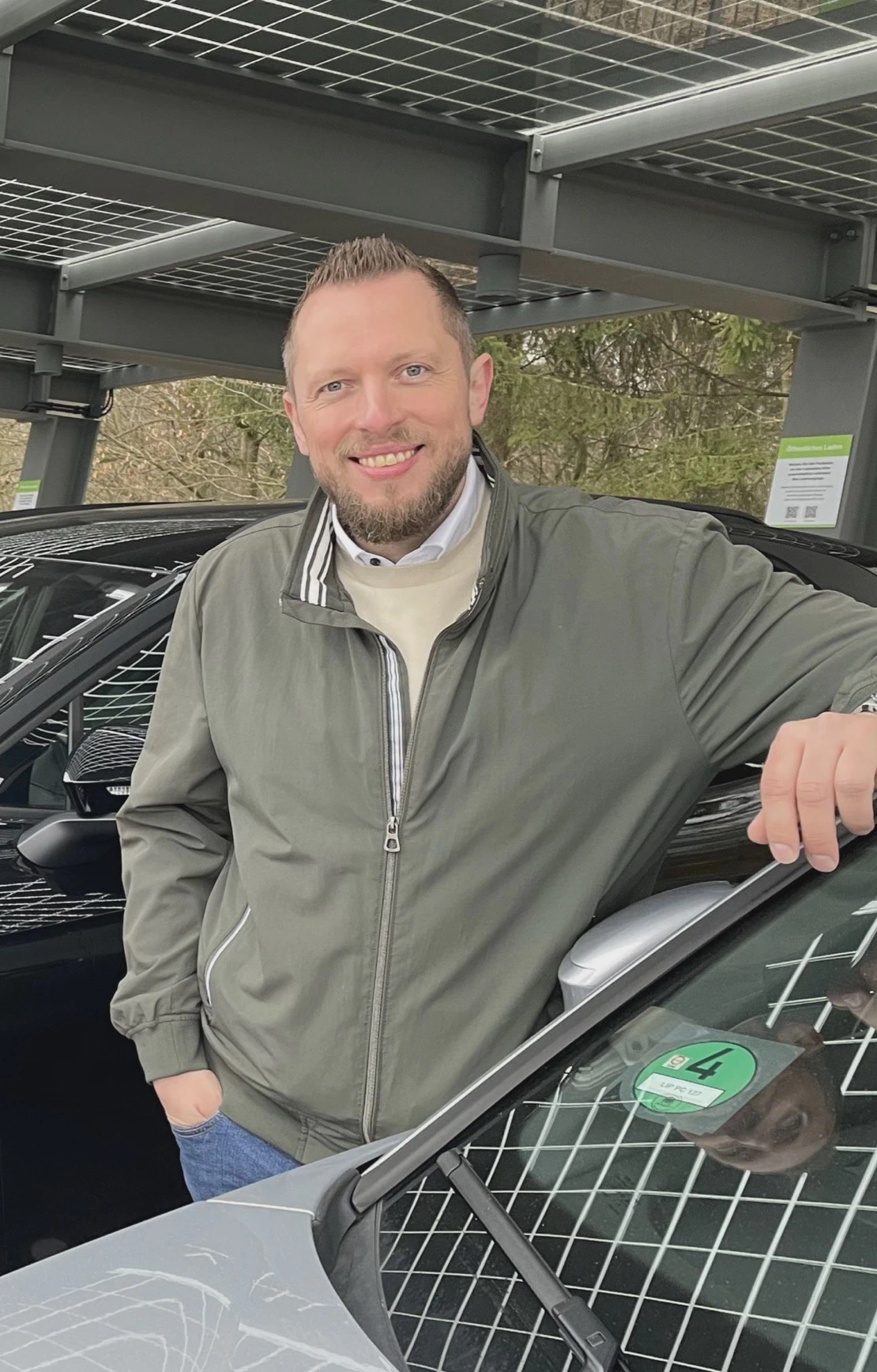In this interview, we speak with Christian Fiege, fleet manager at Phoenix Contact, about the best practices and challenges in the introduction and use of E-company car fleets. Phoenix Contact has set the goal of having a fully electrified fleet by 2030. Christian provides us with insights into the current fleet, the charging infrastructure, management, and the economic as well as sustainable benefits of E-company cars.
Insights into the E-Company Car Fleet and Its Challenges
Maike Eggengoor: Can you give us an overview of Phoenix Contact’s current E-company car fleet?
Christian Fiege: Our fleet in Germany comprises about 650 vehicles, of which around 40% are fully electric and 33% are plug-in hybrids. With our new company car policy, we promote more sustainable mobility by currently including mainly PHEVs (Plug-in Hybrid Electric Vehicles) and BEVs (Battery Electric Vehicles). Our goal is to have a fully electrified fleet by 2030. Phoenix Contact’s fleet consists of three major user groups: personal company cars, pool vehicles, and departmental vehicles.
Maike Eggengoor: What challenges have you encountered in introducing E-company cars into your fleet?
Christian Fiege: The biggest challenge was establishing a uniform charging infrastructure. Questions regarding billing, tax considerations, and standardized charging infrastructure at various locations had to be resolved. It was important that company car users find a consistent charging infrastructure at every Phoenix Contact location in Germany. Billing for home electricity and integrating photovoltaic systems posed additional challenges. Billing for home electricity consumption required a user-friendly and transparent system to ensure that company car users could easily and accurately bill the electricity they actually consumed.

Charging Infrastructure at Phoenix Contact
Maike Eggengoor: How did you establish the charging infrastructure for the E-company car fleet?
Christian Fiege: We have established three main options for charging the E-company cars:
**Public Charging Network: **In the public network, we work with a provider and have provided our drivers with a charging card that allows them to easily find and activate charging stations.
**Company Locations: **At company locations, drivers can verify and charge using an RFID tag at the existing charging infrastructure.
**Home: **For home charging, we introduced the Charge Repay Service, developed by Phoenix Contact Smart Business GmbH, to effectively address the mentioned challenges. This service enables any home wallbox to charge E-company cars. Thus, it is no longer a problem if drivers have already installed a wallbox at home through subsidies or private use. The integration of photovoltaic systems remains unaffected and can continue to be used.
Download our charge@home Guide now!
Our guide highlights the requirements for a home charging solution and explains what is needed to use it for legally compliant billing of company cars. Learn more about the installation of wallboxes, legal frameworks, and efficient billing solutions for home charging.
REQUEST GUIDE
Efficient Use and Management of the E-Company Car Fleet
Maike Eggengoor: How do you ensure that the E-company cars are used efficiently?
Christian Fiege: The efficient use of E-company cars is ensured through pool vehicles and a booking tool. These pool vehicles are available to employees for business trips and can be reserved via a booking tool.
Maike Eggengoor: What IT solutions or software do you use to manage the fleet?
Christian Fiege: To manage the E-company car fleet, we work with a specialized fleet service provider. For our fleet, we use advanced fleet management software that provides us with comprehensive reports and analyses. This software enables efficient document management and gives us insights into vehicle usage and maintenance needs. This allows us to optimally manage our vehicles and ensure their operational readiness.
Sustainability Strategies and Savings through E-Company Cars
Maike Eggengoor: How do your E-company cars contribute to Phoenix Contact’s sustainability strategy?
Christian Fiege: The E-company car fleet significantly contributes to the sustainability strategy by improving the CO2 balance. Phoenix Contact has set the goal of an “All Electric Society,” and the fleet plays a central role in this. Every electric vehicle helps reduce CO2 emissions.

Maike Eggengoor: What savings and benefits have you achieved through the use of E-company cars?
Christian Fiege: Savings have been achieved in maintenance costs and energy consumption:
Maintenance Costs: Electric vehicles require less maintenance as they do not need engine oil or transmission oil, and regenerative braking preserves the brakes.
Energy Consumption: The annual evaluation clearly shows that the fleet’s CO2 emissions have been significantly reduced.
Future and Development of the E-Company Car Fleet
Maike Eggengoor: What are your plans for the future expansion of the E-company car fleet?
Christian Fiege: As mentioned earlier, we plan to fully electrify the fleet. Our goal is to have a 100% electric fleet by 2030.
Maike Eggengoor: What new technologies or trends do you see in the field of electromobility that could be relevant for Phoenix Contact’s fleet?
Christian Fiege: An exciting technology is bidirectional charging, where electricity from the vehicle can be fed back into the grid. This could play an important role in the future, especially to mitigate energy supply peaks. There are already interesting approaches and technical solutions, but the tax considerations are still open.
Conclusion
The interview with Christian Fiege provides valuable insights into the best practices and challenges in the use of E-company car fleets. Phoenix Contact demonstrates how a well-thought-out strategy and solid infrastructure can enable the transition to an electrified fleet. By focusing on sustainability and efficiency, it becomes clear that E-company cars not only offer ecological benefits but also bring economic savings.




